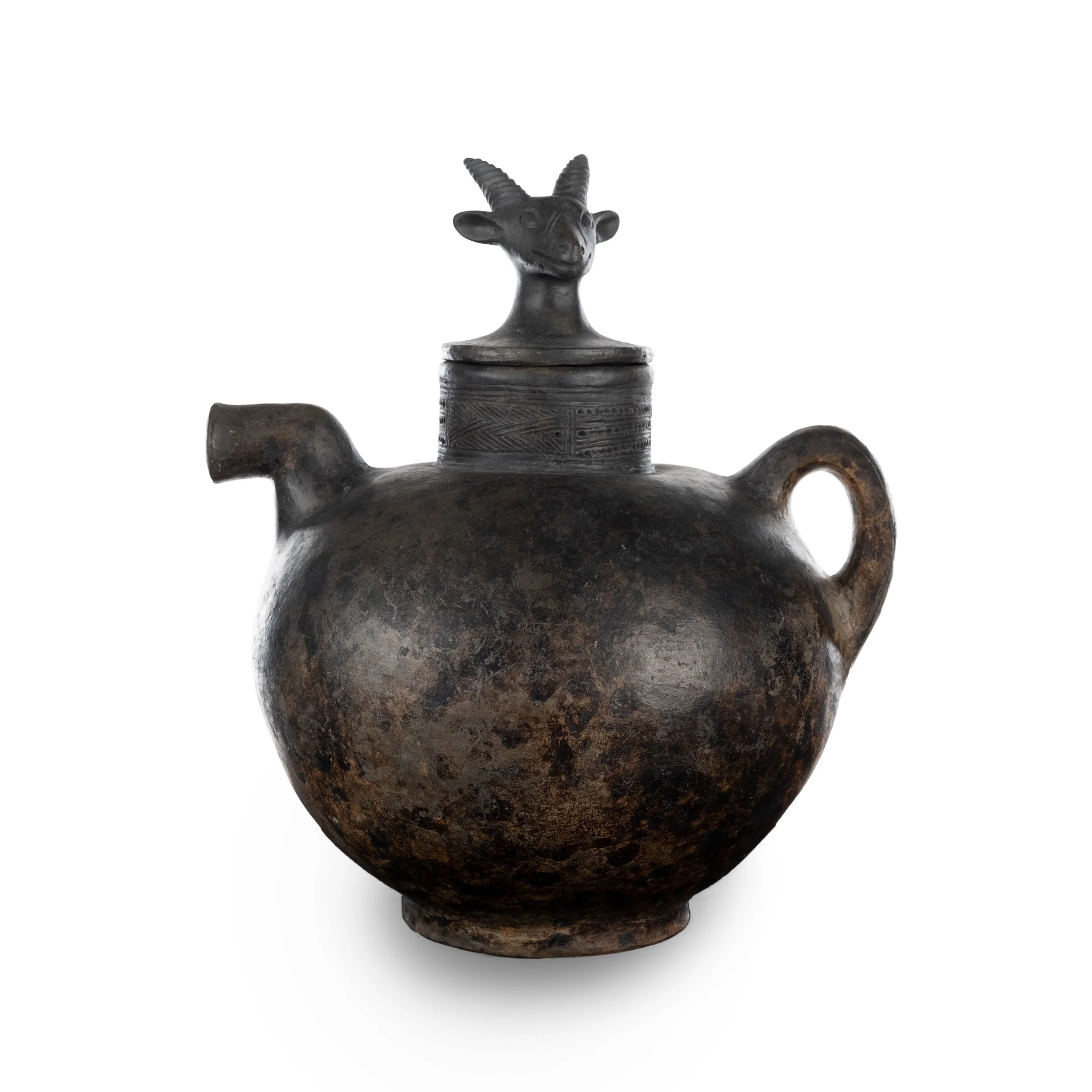 Image 1 of 15
Image 1 of 15

 Image 2 of 15
Image 2 of 15

 Image 3 of 15
Image 3 of 15

 Image 4 of 15
Image 4 of 15

 Image 5 of 15
Image 5 of 15

 Image 6 of 15
Image 6 of 15

 Image 7 of 15
Image 7 of 15

 Image 8 of 15
Image 8 of 15

 Image 9 of 15
Image 9 of 15

 Image 10 of 15
Image 10 of 15

 Image 11 of 15
Image 11 of 15

 Image 12 of 15
Image 12 of 15

 Image 13 of 15
Image 13 of 15

 Image 14 of 15
Image 14 of 15

 Image 15 of 15
Image 15 of 15
















Large Chokwe Ewer with Antelope Lid
Artist: Kalandjisa (Pictured)
Tribe: Chokwe (Dilolo, Congo, Africa)
Date: 1960
About:
The Chokwe are a Niger-Congo speaking matrilineal people in the Lunda cluster of the Central Bantu.
Historically, Chokwe pottery was made by men and is a fairly rare skill, commanding high prices. Kalandjisa was the only Chokwe artist at the time to make his living exclusively from the sale of his products. Other artists carried on farming as their main source of livelihood. (Art and Aesthetics in Primitive Societies p. 317).
According to the writings, “these large carafes or ewers were popular objects around Dilolo, often surmounted by a lid with a human head or figure in traditional wood carving style. These carafes in black or pale gray clay, are virtually unreported in the literature, and may be influenced by European forms, but in any case are among the chefs-d'oeuvre of the Chokwe and their neighbors to the south, the Luena.” (Art and Aesthetics in Primitive Societies, p. 321. Reprinted from The Journal of Aesthetics and Art Criticism, Vol. XXIV, No. 4 Summer 1966 p. 519-24, Dr. Daniel J. Crowley).
Provenance:
The carafe was collected from the artist by Frank Biedka in 1960 during a field trip under the direction of Dr. Daniel Crowley (Chairman of the Department of Anthropology at the University of California at Davis) and supported by the Ford Foundation. Dr. Crowley was the leading expert on Chokwe art until his passing in 1998.
The piece was acquired directly from the estate of Frank Biedka including the original photograph of the potter with this ewer and another made for Dr. Crowley.
Condition:
The item had received damage when in the possession of the original owner. It was restored, with no expense spared, by museum art repair specialist, Broken Art Restoration Inc. Before and after pictures of the invisible restoration are shown.
Artist: Kalandjisa (Pictured)
Tribe: Chokwe (Dilolo, Congo, Africa)
Date: 1960
About:
The Chokwe are a Niger-Congo speaking matrilineal people in the Lunda cluster of the Central Bantu.
Historically, Chokwe pottery was made by men and is a fairly rare skill, commanding high prices. Kalandjisa was the only Chokwe artist at the time to make his living exclusively from the sale of his products. Other artists carried on farming as their main source of livelihood. (Art and Aesthetics in Primitive Societies p. 317).
According to the writings, “these large carafes or ewers were popular objects around Dilolo, often surmounted by a lid with a human head or figure in traditional wood carving style. These carafes in black or pale gray clay, are virtually unreported in the literature, and may be influenced by European forms, but in any case are among the chefs-d'oeuvre of the Chokwe and their neighbors to the south, the Luena.” (Art and Aesthetics in Primitive Societies, p. 321. Reprinted from The Journal of Aesthetics and Art Criticism, Vol. XXIV, No. 4 Summer 1966 p. 519-24, Dr. Daniel J. Crowley).
Provenance:
The carafe was collected from the artist by Frank Biedka in 1960 during a field trip under the direction of Dr. Daniel Crowley (Chairman of the Department of Anthropology at the University of California at Davis) and supported by the Ford Foundation. Dr. Crowley was the leading expert on Chokwe art until his passing in 1998.
The piece was acquired directly from the estate of Frank Biedka including the original photograph of the potter with this ewer and another made for Dr. Crowley.
Condition:
The item had received damage when in the possession of the original owner. It was restored, with no expense spared, by museum art repair specialist, Broken Art Restoration Inc. Before and after pictures of the invisible restoration are shown.
